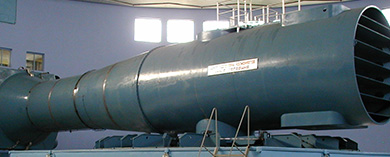
- (03) 5909 8218
- enquiry@fusionweld.com.au
Pressure Vessels: Typical closure styles, materials, and sizes
March 20, 2014

A pressure vessel is a type of receptacle that is usually made of steel. These containers are made to store different types of liquids and gases at pressures that are significantly different to the adjacent environment. Sealed off structures with nuclear reactor cores are also considered as pressure vessels. One other aspect of pressure vessels is that they have the capacity to stand pressures beyond 15 psi. These containers can hold gasses, liquids, and even solids at high temperatures and pressures. Tankers carrying hazardous chemicals can also be considered as pressure vessels.
The use of pressure vessels have become a necessity in many industries as well as in most homes, however, because they are pressurized, they pose a number of risks if not maintained and handles properly.
Types of pressure vessels
There are pressure vessels with open or closed ends. Most pressure vessels that we see are cylindrical in shape, but they can also be designed in other shapes and sizes. Some samples of closed-end pressure vessels include tankers containing liquid nitrous oxide, liquid nitrogen, and other gasses. On the other hand, samples of open-ended pressure vessels include tubes and pipes that link pressure areas to one another. They are present in factories and large commercial kitchens. Open-ended pressure vessels are designed to stand up to substantial amount of pressure moving within them. They usually have armour-coated sides for extra protection.
Uses of pressure vessels
Different industries use various pressurized gasses and liquids in their operation. In order to transport large amounts of chemicals, pressure vessels are used. There are home gadgets that can be considered as pressure vessels such as fire extinguishers and LPG tanks. The cylindrical tanks containing harmful gasses such as oxygen being towed by trucks are pressure vessels.
The risks involved
A small crack or leak in a pressure vessel poses risky possibilities. The highly pressurized container can explode if the leak gets large enough forcing the air pressure on the sides of the container to weaken. Mishandling resulting in accidents such as massive collisions can result in the explosion of the hazardous contents of the pressure vessel. Leaks and cracks can also allow lethal gas to escape causing people within the vicinity to suffocate.
That is why individuals who work and deal with pressure vessels regularly should have ample training in the proper handling of these materials. Fundamental training should include putting out fire especially in emergency situations, the different types of fires caused by different chemicals and the methodologies to be applied in order to effectively put them out, and the proper care and maintenance of the containers. There are training certification programs available to educate people on the appropriate ways to handle pressure vessels.
Pressure vessels can come in many shapes but the most popular and ideal pressure vessel forms are those that are spherical in shape. Spherical pressure vessels possess more strength than cylindrical pressure vessels.
Contact Details
Fusion - Weld Engineering Pty Ltd
ABN 98 068 987619
1865 Frankston Flinders Road,
Hastings, VIC 3915
Ph: (03) 5909 8218
Optimized by NetwizardSEO.com.au
Recent Posts
- Custom Pressure Vessel Fabrication for Flammable Gases
- Heat Exchangers for Oil & Gas Refineries - Custom-Built for Performance & Compliance
- Fusion-Weld’s Custom Pressure Vessels: Australian-Made for Safety, Compliance & Reliability
- Pressure Vessel Manufacturers Australia - Precision-Built for Oil and Gas Standards
- Pressure Vessel Replacement for Aged Components: A Compliance-Focused Approach
- Remote Visual Inspection: Pressure Vessel Maintenance
- Pressure Vessel Design and Fabrication – How to Meet Compliance Standards
- Air Receiver Vessels: Essential Storage for Efficient Air-Powered Operations
- Anhydrous Ammonia Storage Vessel Fabrication: Modern Control Systems for Safe Storage
- Self-Bunded Tanks: Secure Fuel and Chemical Storage for the Power and Petrochemical Sectors
- Australian Fabrication Excellence: Custom Pipe Spooling Projects by Fusion-Weld Engineering
- Deaerators and Feedwater Vessel Inspection: Extending Service Life
- How Remote Visual Inspection Reduces Pressure Equipment Downtime
- Large Process Vessels: Optimising the Design for Maximum Efficiency [2025]
- Pressure Equipment Management System Installation: Detect Equipment Faults Early
- Safety Standards for Static Pressure Vessels: What Operators Need to Know
Posts 2025
- Custom Pressure Vessel Fabrication for Flammable Gases
- Heat Exchangers for Oil & Gas Refineries - Custom-Built for Performance & Compliance
- View all articles…
Posts 2024
- Large Process Vessels: Optimising the Design for Maximum Efficiency [2025]
- Pressure Equipment Management System Installation: Detect Equipment Faults Early
- View all articles…
Posts 2023
- Pressure Piping System Inspection: A Gift of Safety for the Holidays
- Deaerator Inspections by Fusion-Weld Engineering and How They Reduce System Downtime
- View all articles…
Posts 2022
- How Fusion Weld Keeps Up With AS-NZS ISO 9001:2008 Standard
- Boiler Equipment Safety Inspection During the Summer Season
- View all articles…
Posts 2021
- Avoid These Factors and Practices that Contribute to Sealing Damage in Pressure Vessels
- Do's And Don'ts Of Industrial Boiler Inspection And Maintenance From Fusion-Weld
- View all articles…
Posts 2020
- What are the Risks and Hazards Involved in Pressure Vessel Equipment?
- How to Know if Your Pressure Equipment Needs Repair or Replacement?
- View all articles…
Posts 2019
- Factors that Contribute to Pressure Vessel Failure
- Pressure Vessel Regulations in Australia: What are the Mandatory Requirements?
- View all articles…
Posts 2018
- Pros and Cons of Spherical vs. Cylindrical Pressure Vessels
- What are the Different Hazard Levels in Pressure Vessels?
- View all articles…
Posts 2017
- Transportable Pressure Vessels: The Importance of Inspection and Safety Checks
- Fracture Mechanics and Stress Analysis of Cracks in Pressure Vessels
- View all articles…
Posts 2016
Posts 2015
- What Are Deaerators & Feedwater Vessels?
- Precautions and Safety for Compressed Air Receiver Vessels
- View all articles…
Posts 2014
- Demonstrating In-process Inspection Procedures
- Static Grounding Practices and Standards
- View all articles…